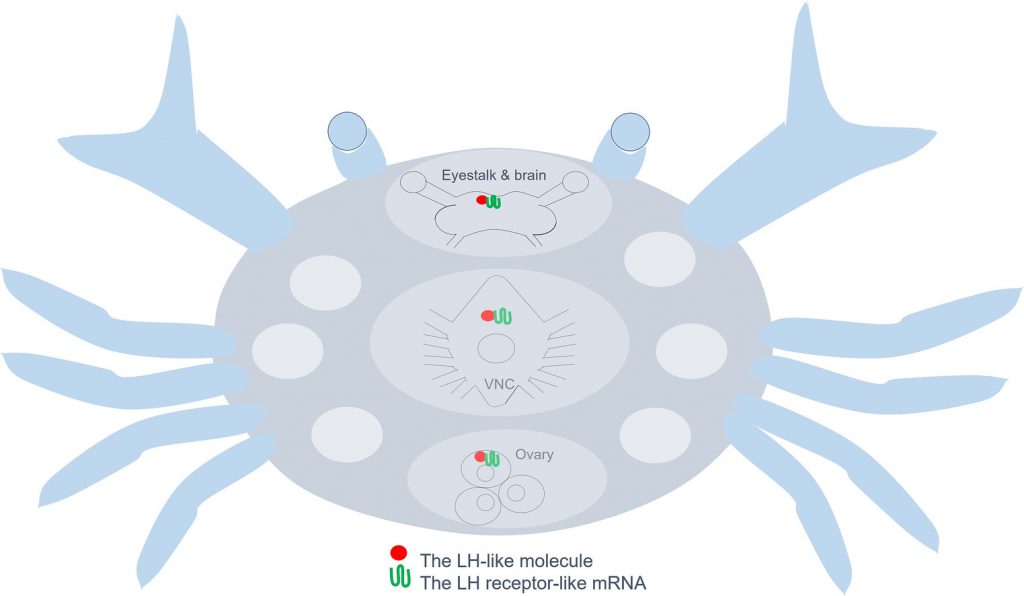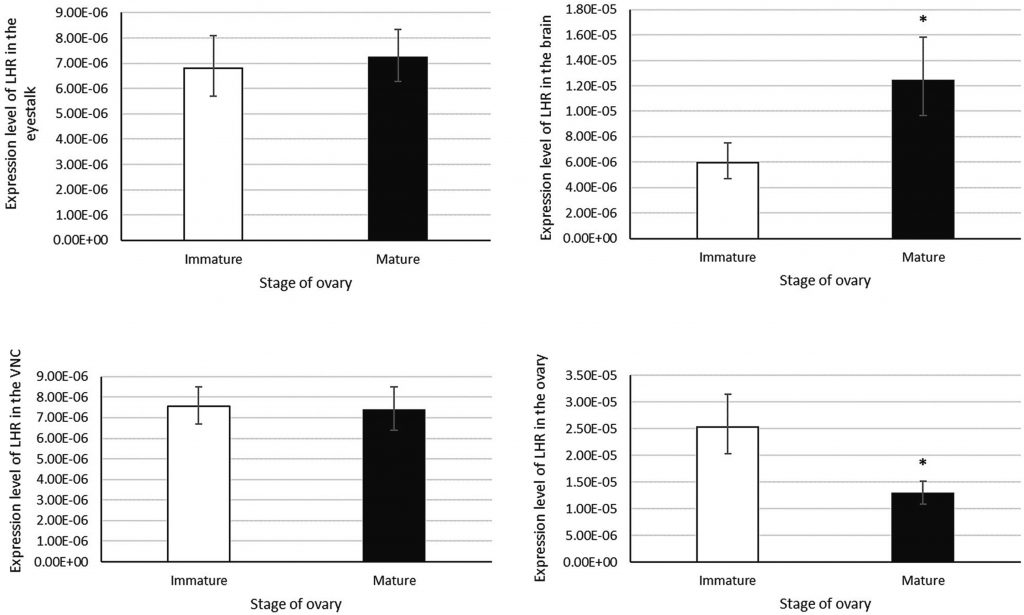

Highlight
งานวิจัยนี้ค้นพบว่าในปูม้า (blue swimming crab) มีโมเลกุลที่คล้ายฮอร์โมน LH (luteinizing hormone) และตัวรับ (receptor) ของฮอร์โมนนี้ ซึ่งมักพบในสัตว์มีกระดูกสันหลัง โดยตรวจพบทั้งในระบบประสาทส่วนกลางและรังไข่ของปูม้า โดยเฉพาะในรังไข่ที่เจริญเต็มที่ การค้นพบนี้ช่วยเปิดมุมมองใหม่เกี่ยวกับระบบฮอร์โมนที่ควบคุมการสืบพันธุ์ของปูม้า ซึ่งอาจนำไปสู่การพัฒนาวิธีเพาะเลี้ยงปูม้าในฟาร์มโดยไม่ต้องตัดตาแม่ปู (eyestalk ablation) และช่วยแก้ปัญหาการลดจำนวนปูม้าในธรรมชาติในระยะยาว
ที่มาและความสำคัญ
ปูม้า (Portunus pelagicus) เป็นสัตว์น้ำเศรษฐกิจที่สำคัญของไทยและหลายประเทศในภูมิภาคเอเชียตะวันออกเฉียงใต้ เนื่องจากมีมูลค่าทางเศรษฐกิจสูงและเป็นแหล่งรายได้หลักของชุมชนชายฝั่ง อย่างไรก็ตาม ปริมาณปูม้าในธรรมชาติลดลงอย่างต่อเนื่อง งานวิจัยนี้ได้ค้นพบโมเลกุลที่มีลักษณะคล้ายฮอร์โมน LH (Luteinizing Hormone) และตัวรับ (receptor) ของฮอร์โมนดังกล่าวในปูม้า ซึ่งปกติแล้วจะพบในสัตว์มีกระดูกสันหลังเท่านั้น โดยตรวจพบทั้งในระบบประสาทส่วนกลางและรังไข่ของปูม้า โดยเฉพาะในรังไข่ที่เจริญเต็มที่ นอกจากนี้ยังสามารถระบุลำดับพันธุกรรมของตัวรับฮอร์โมนนี้ในปูม้า และพบว่ามีความคล้ายคลึงกับสัตว์ไม่มีกระดูกสันหลังชนิดอื่นๆ การแสดงออกของยีนตัวรับนี้พบมากในสมองของปูม้าที่โตเต็มวัย และน้อยลงในรังไข่ของปูม้ากลุ่มเดียวกัน การค้นพบนี้ถือเป็นก้าวสำคัญในการทำความเข้าใจระบบฮอร์โมนที่ควบคุมการสืบพันธุ์ของปูม้า ซึ่งอาจนำไปสู่การพัฒนาเทคนิคการเพาะเลี้ยงปูม้าแบบยั่งยืนโดยไม่ต้องใช้วิธีการตัดตาแม่ปู (eyestalk ablation) ที่เป็นวิธีเดิมในปัจจุบัน และช่วยแก้ไขปัญหาการลดจำนวนปูม้าในธรรมชาติได้ในอนาคต ทั้งยังเป็นการเปิดประตูสู่การศึกษากลไกชีววิทยาของสัตว์น้ำเศรษฐกิจชนิดอื่นๆ อีกด้วย
Abstract
Knowledge of the neuroendocrine system possibly improves the reproductive performance of captivated crustacean broodstock in aquaculture and it may substitute eyestalk ablation. In this study, we explored the luteinizing hormone (LH)-like molecule and proved the existence of the LH receptor (PpelLHR)-like mRNA in the blue swimming crab, Portunus pelagicus. Using the anti-human LH-β antibody, the immunoreactivities were found in the central nervous system (CNS) and ovary of the crab with the strongest signal in the mature ovary. The full-length PpelLHR-like mRNA sequence contained 4818 bp with deduced protein predicted as seven transmembrane G-protein coupled receptor, made of 1605 amino acids. The phylogenetic tree suggested this protein belonged to the clade of invertebrate LHR/FSHR-like proteins. The PpelLHR-like mRNA expressed in various organs and real-time qPCR revealed significantly higher expression of this mRNA in the brain and lower expression in the ovary of the mature crabs. In situ hybridization of this mRNA was demonstrated in neuronal clusters of the brain, ventral nerve cord, and in the oocyte stage 1–4 of the ovary, respectively. This study was preliminary to prove the existence of LH and its receptor in the blue swimming crab. Functional assay of this receptor should be performed as the next part of experiments to firmly conclude its appearance.
Keywords: The LH immunoreactivity, The LHR-like mRNA, Central nervous system, Ovary, The blue swimming crab
Citation: Saetan U, Kornthong N, Duangprom S, Songkoomkrong S, Phanthong P, Sanprick A, Tipbunjong C, Tamtin M, Saetan J. The occurrence of luteinizing hormone-like molecule and its receptor in the blue swimming crab, Portunus pelagicus. Comparative Biochemistry and Physiology Part A: Molecular & Integrative Physiology. 2025 Jan 1;299:111753. https://doi.org/10.1016/j.cbpa.2024.111753
RELATED SDGs:
SDG Goal หลัก ที่เกี่ยวข้อง
14. LIFE BELOW WATER

ผู้ให้ข้อมูล: ผู้ช่วยศาสตราจารย์ ดร.เพชรัตน์ พานทอง
ชื่ออาจารย์ที่ทำวิจัย: ผู้ช่วยศาสตราจารย์ ดร.เพชรัตน์ พานทอง
Webmaster: ว่าที่ ร.อ. นเรศ จันทรังสิกุล
Tags: Central nervous system, Ovary, The blue swimming crab, The LH immunoreactivity, The LHR-like mRNA
